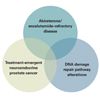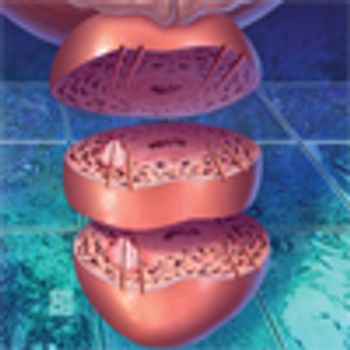
Tumor expression of the oncogene ERG might predict patient benefit from adding docetaxel to androgen deprivation therapy, according to analyses of two phase III clinical trials.

Your AI-Trained Oncology Knowledge Connection!



Tumor expression of the oncogene ERG might predict patient benefit from adding docetaxel to androgen deprivation therapy, according to analyses of two phase III clinical trials.

A molecular signature for aggressive-variant prostate carcinoma can predict which men with castration-resistant prostate cancer will benefit from cabazitaxel with or without carboplatin.

Abiraterone at the start of ADT for men with metastatic prostate cancer significantly improved overall survival and failure-free survival, with manageable toxicity.

Combined therapy with abiraterone acetate/prednisone plus ADT significantly improved overall survival and radiographic progression-free survival among men with metastatic hormone-naive prostate cancer.

In this interview ahead of ASCO 2017 we discuss the physical and cognitive effects of androgen deprivation therapy in older men treated for prostate cancer.

Molecular subtyping of prostate cancer into three categories-luminal A, luminal B, and basal-identifies differences in prognosis and response to treatment.

Urinary testing for PCA3 and TMPRSS2:ERG (T2:ERG) RNA can help avoid unnecessary biopsies while maintaining ability to detect aggressive prostate cancer.

A prospective phase III validation study found that AZGP1 has significant prognostic utility as a biomarker in localized prostate cancer.

A study may be able to identify which men with aggressive prostate cancer will benefit from androgen deprivation therapy.

In this review of active surveillance for favorable-risk prostate cancer, we will discuss the rationality of this approach, the biological evidence for employing active surveillance in Gleason pattern 3 and 4 prostate cancer, patient selection for active surveillance, clinical trial data on active surveillance, and the role of prostate cancer biomarkers and imaging studies for clinical decision making in patients with low-risk disease.

Two new studies presented at the Annual Scientific Meeting of the American Urological Association offer an improved understanding of some genetic underpinnings of prostate cancer.

Active surveillance can yield excellent results in carefully selected younger men with prostate cancer, according to a new study presented at the AUA Annual Meeting.

In this interview we discuss a study that looked at the effect of an 8-week exercise intervention on treatment side effects for patients with prostate cancer.

Increased consumption of Italian-style coffee appeared to have a protective effect against prostate cancer in a large observational study.

The higher prostate cancer death rates seen among black men in the United States may be due to a higher incidence of preclinical disease and higher risk of metastatic progression, suggesting that different screening policies could benefit this population.

PARP inhibitors are an active, novel, and exciting class of anticancer agents. They have shown clear patient benefit in gBRCA, HR-deficient, and other ovarian cancers.

Sexual and urinary morbidities resulting from treatment of pelvic malignancies are common. Awareness of these complications is critical in order to properly counsel patients regarding potential side effects and to facilitate prompt diagnosis and management.

The use of multi-parametric magnetic resonance imaging could help avoid a repeat prostate biopsy in some men, according to a new study.

In this video, David Goodrich, PhD, of Roswell Park Cancer Institute in Buffalo, discusses treatment resistance and disease relapse in prostate cancer.

The addition of custirsen to docetaxel and prednisone failed to improve overall survival among patients with metastatic castration-resistant prostate cancer in a phase III trial.

An uncommon but significantly burdensome sequela of therapy for prostate cancer is pubic bone osteomyelitis in association with a pubosymphyseal urinary fistula.

Men who receive testosterone replacement therapy had an increased rate of favorable-risk prostate cancer compared to those who did not use the therapy, and a decreased rate of aggressive prostate cancer.

A mathematical approach revealed a set of criteria that could help define prostate cancer patients with poor prognosis, according to a new analysis. This could help many patients avoid overtreatment.

Men with painful bone metastases from prostate cancer may be able to achieve clinically meaningful improvements in pain and quality of life as early as 10 days after undergoing radiotherapy.

The Decipher prostate cancer gene-expression classifier can predict patients’ risk of metastasis and prostate cancer-specific mortality using biopsy specimens prior to radical prostatectomy or radiotherapy plus androgen deprivation.